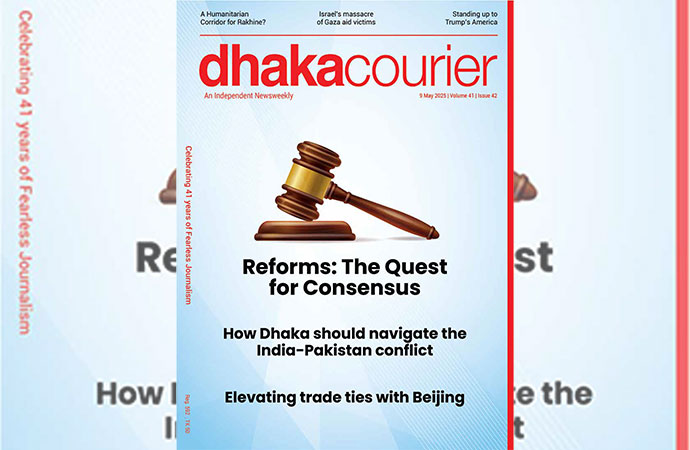Column

Hans Christian Andersen, Danish author and poet, 1869. Photo: Collected
Fairy tales are designed to amuse, instruct, warn, and enlighten. They usually set out to conquer fears generated by natural, human, and bestial terrors that threaten to destroy free will and human passion. Time was these stories were meant largely for children. But 'the child is the father of man', and eventually their relevance for all ages became evident. That was the broad theme of discussion at the April virtual meeting of the Dhaka-based 'The Reading Circle', chaired by Professor Niaz Zaman, with membership drawn from around the world. It is focused on global literature, classical and contemporary, including in South Asia. The works chosen for the deliberations were by the nineteenth century Danish short story writer, Hans Christian Andersen. Presentations were made by Asfa Hussain, Nusrat Huq, Tazeen Murshid, Tanveerul Haque, Shireen Mainuddin, Sanjeeta Hossain and me. Many others listened- in, and also participated.
Hans Christian Andersen generally constructed his morality tales by relying on simple metaphors and familiar settings. These were meant to praise the virtues of the Protestant ethic, while giving life to the discourses of the dominated. His stories attacked false pride and greed of the aristocracy. Some critics, however, contended that he tended to ignore the same among bourgeois classes. Many of his narratives underscored the ambivalence about his working- class origins and dependence upon the patronage of the nobility. While his works show sensitivity to class struggle, they also reflect a genuine admiration of the Danish upper classes.
Europe in the 19th century was undergoing religious, political and intellectual upheavals of immense proportions. Northern Europe, Denmark included, was battling the ultra-conservative influence of the Catholicism of the South. The post-Napoleonic era and the arrangements arrived at in the Congress of Vienna sealed the indigenous power of local sovereigns. The Protestant ethic, the harbinger of the scientific age, championed human endeavour. It viewed honest labour as more worthwhile worship offered to the Creator than prayers in Church in the pews of the prosperous. At the same time Marxist and socialist values were challenging prevalent mores and cheering the downtrodden in what they viewed as a legitimate class-struggle. In this milieu, some in the European literary world, Andersen included, were seeking to speak truth to power. An example is his short story, cum fairy tale, "The Emperor's New Clothes'
In it, a monarch who is excessively fond of sartorial excellence, parades naked in a public procession. He finds himself in this ridiculously embarrassing position because he is seduced by his own greedy and irrational desire to wear the finest attires, as well as fraudulent entrepreneurs in the form of two cheats. They claimed to have woven for him such unique garments that cannot be seen by fools or those unfit for high office. He is also undone because he is surrounded by self-serving officeholders, not unlike many of Europe's prevalent bureaucracies. Once the swindle is set in motion, the entire community collaborates with the myth of the Emperor's New clothes. Nobody would let it appear that he or she could see nothing. Fearful of losing status and authority, intimated by powerful concerns, and unwilling to be seen as a fool, everyone in town, from the highest to the lowest, agreed as to how magnificent the Emperor's new attire, unseen by all and sundry because it did not actually exist, was.
In this tale the Emperor is corporeally and metaphorically exposed as the fool in the story. This, while the entrepreneurial swindlers, sycophantic retainers, and the cowed population go unpunished. These facts also illustrate Andersen's ideological commitments and ambivalences. The story is clear in warning us against simple remedies to complex problems. For example, the creating of easy litmus tests for distinguishing the wise from the foolish and the competent from the inept. The Emperor ended up naked because each of his subject thought the other could see, and no one wanted to be revealed a fool. Except for a child, whose innocence was unsmeared by those negative societal values. The eyes of the child were used to challenge conventional wisdom, and help others see more clearly. It is a tale cautioning us against generating and feeding yet unreasonable desires, and also demonstrating the power of conformity.
That was a sharp political and social message clothed in the paradigm of a fairy tale. Some of his other stories also come close to a parable where there are hidden meanings, either revealed or left to the reader to surmise. For instance, to say that 'The Little Mermaid' is about love is to be too reductive; obviously, the mermaid seeks something higher and beyond? It is a bit of a paradox. If viewed through ordinary lens it is a tragic tale of unrequited love. But if examined through a spiritual prism, it has a happy ending as the mermaid's soul gains immortality. Andersen rather tantalizingly invites interpretation: Is it about selflessness, or feminism, or love or religion or immortality? Or is it about all of these packed into a paean of praise to divine rules? One is left to draw one's own conclusions!
Interestingly, it is part of a genre of European literature where a section of the readership, in this case children, is invited to be participant in the event. If the child behaves well. It helps reduce the time spent in limbo before salvation of the soul of the mermaid. If it does not, its bad behaviour will lengthen the wait. A modicum of emotional and moral pressure is thus applied for good conduct on the child's part. It is similar to the lesson put across by the Scottish novelist, JM Barrie. According to him a child's first laughter splinters into a thousand dancing pieces, each of which becomes a fairy. But each time a child lies, a fairy drops dead. Unsurprisingly, he was critiqued for trying to emotionally blackmail children.
Hans Christian Andersen's spirituality comes through more stridently in his 'The Little Match Girl'. His writing here is stylistically interesting. It is a straightforward narrative in the third person, with little dialogue, no flashbacks and no twists. There is an abundance of Dickensian misery in the little match girl's life associated with poverty, and also cruelty, as of the father. Andersen was initially an ardent admirer of Charles Dickens. But there is an interesting footnote to the story of their relationship which is worth retelling.
Though quite close at the outset, the two writers fell out following a disastrous visit by Anderson to Dickens' home in England, originally planned for a fortnight but extended by Andersen to five weeks. Unfortunately, Andersen's arguably eccentric behaviour during this prolonged sojourn, including his insistence on an archaic and weird custom that the host's son shave his beard every morning, irritated Dickens no end. The latter actually complained to Prime Minister John Russel against Andersen's odd habits. The issue of a guest overstaying welcome was as relevant then as now. One consequence of this unhappy episode, and its impact on literature, was that the somewhat ungainly Anderson was said to have been portrayed in the person of the unctuous, obsequious, and unflattering character of Uriah Heep in the English writer's novel, 'David Copperfield'.
Be that as it may, what also importantly comes through in Andersen's 'The Little Match Girl' is her transition from an unhappy, temporal existence to a happy heavenly abode with her grandmother, with her new life coinciding with the New Year, during the season that marks the birth of Christ, seen by Christians, Catholics and Protestants, as the savior of all men, women and children. Andersen fills this story with a great deal of irony, imagery and symbols, and his unmistakable religiosity.
Andersen's message could also be more complex as in 'The Ugly Duckling'. The conventional perception of the story, often seen a touch autobiographical, is that of a spurned outsider whose virtues are ignored by the rest of the world, and who is only accepted when he transforms into a successful person.
But was it really that? In the story the protagonist was not a duckling in the first place. It was always a baby swan, born of an egg accidentally lodged among those of ducks. But what if it really had been a misshapen baby eventually transforming into a duck, which would have been natural, rather than as a swan? So, the happy ending in the story is a fluke and not the general norm.
The general norm is that if one is an ugly outsider, one will always remain unacceptable. The world is all about tribalism, and rejection, and pain. Cheats will always try to manipulate you as in 'The Emperor's New Clothes', you may not be loved back as in 'The Little Mermaid', the poor will die in misery, as in 'The little Match Girl', and those outside of your ilk will reject you as in "The Ugly Duckling', So is there is there no such thing as happiness or redemption? There is, but as Anderson's middle name 'Christian' suggests, it lies in the life beyond, where one will have one's rewards and punishments. A tad morbid? Yes, but in consonance with the author's spiritual beliefs, widely shared at that time.
In terms of contemporary interpretation, we do discern in the narratives of Andersen marked existentialist streaks, underscoring the determinism of individual will often against an irrational backdrop in an unfair world. His writings flag the dangers of man's manipulation of man, and of accompanying self-alienation and deception. There is the urging that straightforward radical truth- telling is the indispensable instrument of redemption. Oftentimes, reading between the lines, one can see in them the philosophical strains of Fyodor Dostoevsky, Friedrich Nietzsche, and closer to our times, of Jean- Paul Sartre.
These thoughts came to me as I mulled over these stories for days after having re-read them for the seminar. It occurred to me as no one writes the same thesis twice, no one repeats a reading of the same text without deriving a new interpretative meaning. But my first instinctive reaction to poring over the tales yet again was really that these were such fun reads!
Dr Iftekhar Ahmed Chowdhury is the Honorary Fellow at the Institute of South Asia Studies, NUS. He is a former Foreign Advisor (Foreign Minister) of Bangladesh and President and Distinguished Fellow of Cosmos Foundation. The views addressed in the article are his own. He can be reached at: isasiac @nus.edu.sg

























Leave a Comment
Recent Posts
Enayetullah Khan to represent ...
Enayetullah Khan, Editor-in-Chief of United News of Bangladesh (UNB), ...
The tragedy in Ahmedabad touch ...
Air crashes are inherently international incidents, and the emotions t ...
Asset recovery a key focus; breakthroughs from talks ..
'It'll inspire youths to build Bangladesh they dream ..
UK envoy Sarah Cooke happy with Yunus’ visit to Brit ..
Prof Yunus honoured with prestigious Harmony Award b ..